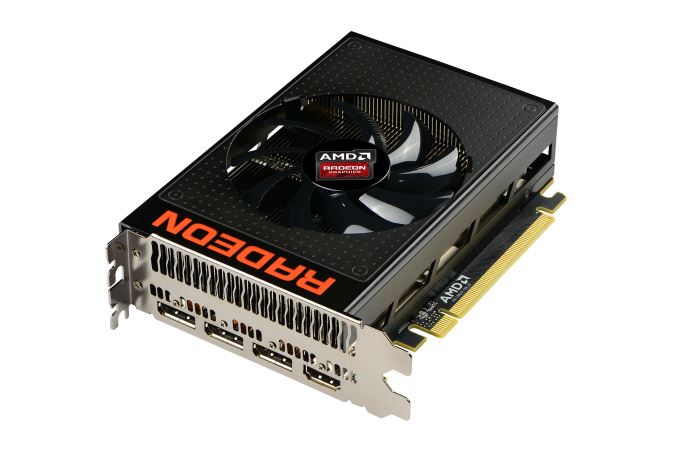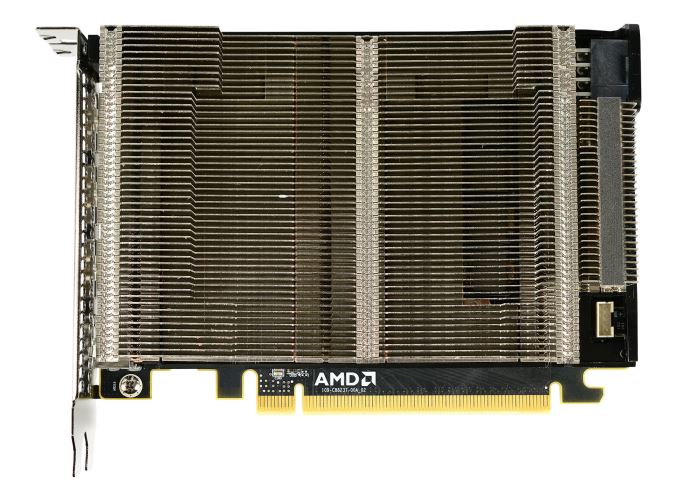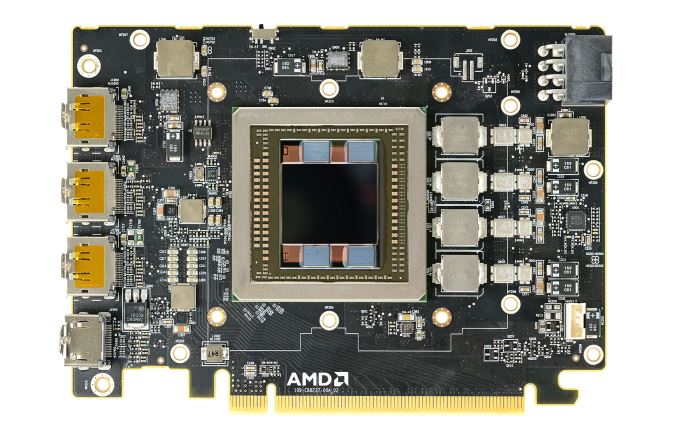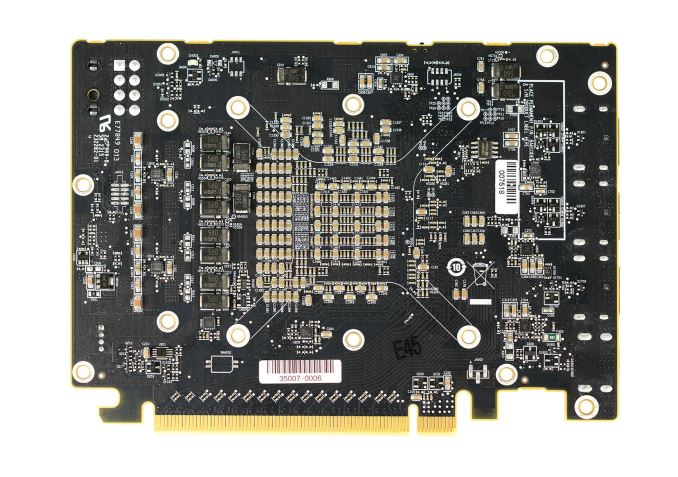The AMD Radeon R9 Nano Review: The Power of Size
by Ryan Smith on September 10, 2015 8:00 AM ESTMeet The Radeon R9 Nano
6 inch video cards are by no means a new thing in the GPU space, however these are traditionally lower-end products that need neither a large cooler nor an extensive power delivery system. As a result the R9 Nano is something of an interesting aberration, packing a lot more power and a lot more technology into half a foot of video card than what we normally see.
Starting as always from the top, the R9 Nano measures 6” long, which is actually a bit shorter than the full length the Mini-ITX standard allows. Responsibility for cooling the card falls to the R9 Nano’s new open air cooler, an aggressive design that has been specifically tailored to allow the card to effectively dissipate 175W of heat in such a small space.
The overall design of the R9 Nano’s cooler is best described as a combination open-air and half-blower hybrid. The design is technically open-air, employing a single axial fan to cool the card. However with only a single fan AMD has been able to align the heatsink fins horizontally and then place the fan in the center of the heatsink. The end result is that roughly half of the heat produced by the card is vented outside of the case, similar to a full blower, while the other half of the heat is vented back into the case. This reduces (though doesn’t eliminate) the amount of hot air being recycled by the card.
The heatsink itself is composed of aluminum and runs virtually the entire length of the card. This is technical a two-piece heatsink, with the primary heatsink composing the bulk of the card, while a much smaller secondary heatsink it found towards the far end of the card and mounted on top of a heatpipe.
Drilling down, we find that the primary heatsink is fed by a combination vapor chamber and heatpipe design. A copper vapor chamber serves to draw heat away from the Fiji GPU and HBM stacks, and then heatpipes are used to better distribute heat to the rest of the heatsink. The use of a vapor chamber in the R9 Nano makes a lot of sense given the fact that vapor chambers are traditionally the most efficient heatsink base type, however the R9 Nano is also unique in that we typically don’t see vapor chambers and heatpipes used together. Other designs such as the high-end GeForce series use a single large vapor chamber across the entire heatsink base, so among reference cards at least the R9 Nano stands alone in this respect. In this case given AMD’s design goals for size and noise, a vapor chamber will play a big part in helping the small card effectively and quietly dissipate 175W.
As for the physical PCB itself, as we can see AMD made it a relatively packed card in order to get the R9 Nano down to 6 inches. Compared to the R9 Fury X reference board, the biggest change here is that AMD has removed a fair bit of power circuitry to save space. By our count there are 4 VRM phases to feed the Fiji GPU, as opposed to the 6 found on R9 Fury X. Power delivery is handled by a single 8-pin PCIe power socket, which is becoming increasingly common, replacing the 2x 6-pin setup for 150W-225W cards.
Meanwhile to further shrink the overall PCB footprint, AMD has moved some of the remaining power delivery circuitry to the back of the card. The front of the card still contains the inductors and heat-sensitive MOSFETs, while a number of capacitors are on the rear of the card (and is why you won’t find a backplate).
Finally, for display I/O R9 Nano is unchanged from R9 Fury X. This means we’re looking at a DVI-free design, with 3x DisplayPort 1.2 and 1x HDMI 1.4 port all along a single row of the I/O bracket. Buyers looking to put together HTPCs will want to be especially mindful of the HDMI 1.4 port; while it's not necessarily a deal-breaker, it does mean that the R9 Nano can't fully drive 4Kp60 TVs, which are slowly but surely becoming more common.
Overall AMD is rather confident in their design for the R9 Nano. The heatsink is built to efficiently dissipate more heat than the 175W the card requires (despite the small size), and as a result we never see the R9 Nano thermally throttle under normal operation. The card’s thermal throttle point is 85C, and in our testing the card never passed 75C, exactly as AMD promised us. What ends up limiting the R9 Nano’s performance then is exactly as expected: the power throttling.
















284 Comments
View All Comments
Gigaplex - Thursday, September 10, 2015 - link
Because the Titan X is too big. This is a product that competes with the 970 mini in size (and efficiency to some extent) while being faster.RafaelHerschel - Thursday, September 10, 2015 - link
Because people like me build small systems. I do have a 'performance' system, but even that system isn't that big. A lot of energy means a lot of heat. There are quite a few practical reasons for smaller systems, but perhaps the most important one is that it seems silly to build a behemoth for a few extra frames per second.ThomasS31 - Thursday, September 10, 2015 - link
Yet, still if I could save $150 just for going a bit bigger case, or a different structured case, that can host longer cards... I would go with the latter as save money. :)My point in "positioning".
ThomasS31 - Thursday, September 10, 2015 - link
And ofc, I may get other benefits with that. Like not noisy like this (a good thing in a living room), and better temps.medi03 - Friday, September 11, 2015 - link
5% faster than gtx 980 at 65% of 980Ti price.mapesdhs - Monday, September 14, 2015 - link
The Nano and 980 Ti are the same price in the UK, with a particular model of 980 Ti being the far more sensible choice wrt performance.The Nano needs to be a lot cheaper to be worth bothering with. I'd rather use a larger case with a 980 Ti for the same cost, or a mini 970 since a product without HDMI 2.0 isn't suitable for 4K by default IMO.
Drumsticks - Thursday, September 10, 2015 - link
I kind of like the Nano. Small form factor stuff is always interesting to me.Also, is there any chance that we can get a directx12 preview of the fury and high end Nvidia cards? Given results other places were seeing for the 390x, I'm REALLY interested.
digitalgriffin - Thursday, September 10, 2015 - link
This makes ZERO sense. Why buy now for DX12 performance when a good crop DX12 games are at least 1, 2 years off? (Due to adoption of windows 10 and development time). You would be an idiot to buy now.Wait for the refresh in about 12 -> 18 months and AMD to get HBM2, fix the lack of ROPs and drop the DP FP support that adds a lot of unneeded transistors (my guess)...if they are still in business.
TheinsanegamerN - Thursday, September 10, 2015 - link
Not to mention, by the time DX12 becomes mainstream, these GPUs will be irrelevant. Like the first DX11 gpus, the geforce 400s. Sure, they work with modern DX11 titles, but they are too slow to be used in said games. nano, fury x, and maxwell will have the same issue.anubis44 - Thursday, September 10, 2015 - link
DX12 games are not 1-2 years off, they're imminent, since porting can be done pretty well directly to DX12 from consoles now. All that's required is Windows 10, and Steam is reporting Win10 already has a 17% adoption rate after only 1 month! At this rate, every gamer on Steam will be running Win10 by Christmas.